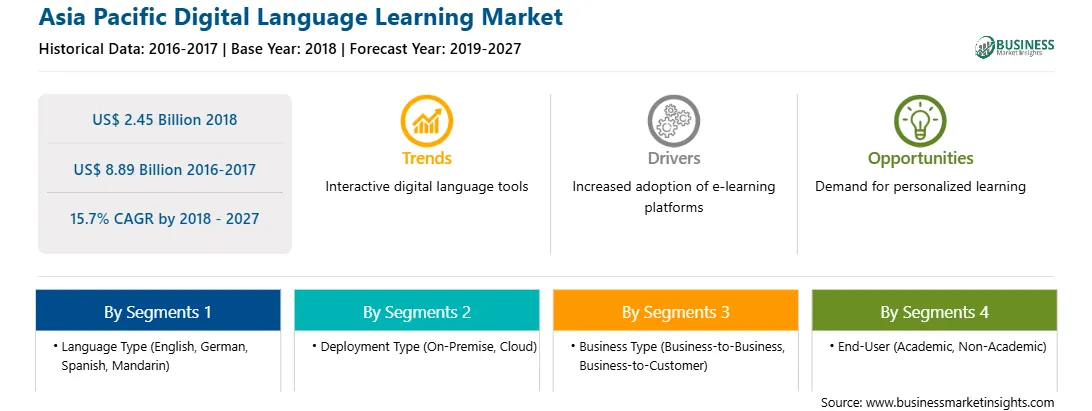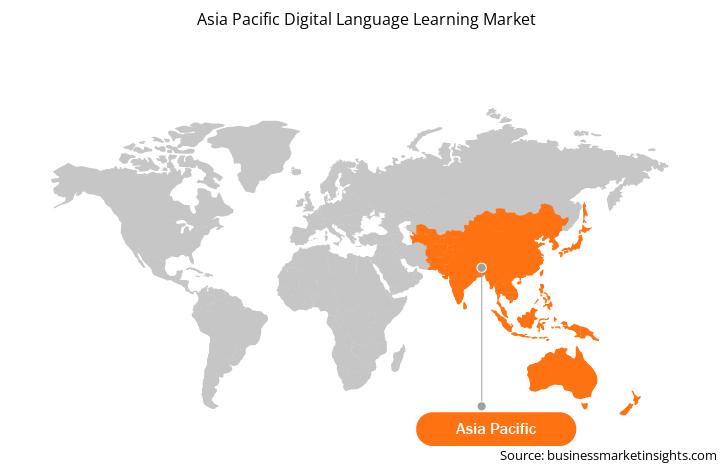Asia Pacific Digital Language Learning Market
No. of Pages: 126 | Report Code: TIPRE00006479 | Category: Technology, Media and Telecommunications
No. of Pages: 126 | Report Code: TIPRE00006479 | Category: Technology, Media and Telecommunications
Asia-Pacific digital language learning market is expected to grow from US$ 2.45 Bn in 2018 to US$ 8.89 Bn by the year 2027. This represents a CAGR of 15.7% from the year 2018 to 2027.
Digital English language learning is witnessing the major demand from both academic and non-academic sectors in Asian countries. The currently increasing trend among Asian students to enroll themselves in universities in the western countries for higher education is creating a significant demand for language learning courses. Majority of the candidates from Asian countries, especially from India and China, enroll themselves for Test of English as a Foreign Language (TOEFL), International English Language Testing System (IELTS), Graduate Record Examination (GRE), Test of English for International Communication (TOEIC), and other language-based courses and certifications. TOEFL and IELTS are the tests conducted to assess a non-native candidate’s English fluency level, including proper English speaking and writing skills. This factor compels the enrolling candidates to opt for English Language Training (ELT) institutes. The burgeoning demand for these competitive exams has led to the establishment of various ELT institutions across these countries, which in turn has opened up avenues for different English learning methods. Moreover, in response to this, various schools, colleges, and universities in India and China have adopted digital learning technologies, and the trend of adoption of the same is consistently increasing. Various ELTs have also incorporated digital English language learning systems and technologies. This factor has positively impacted the growth of the digital language learning market in recent years.
Currently, China is dominating the digital language learning market in Asia-Pacific market owing to the growing popularity of English as a second language and increasing penetration of digitization. The number of students in China is also high, which is a beneficial factor for digital language learning companies to offer their solutions and services. Additionally, the use of internet has been long-established, and the constant advances in the same are enabling the students and candidates to opt for digital languages, which is creating opportunities for digital language learning market. The figure given below highlights the revenue share of the rest of Asia-Pacific in the Asia-Pacific digital language learning market in the forecast period:
Strategic insights for the Asia Pacific Digital Language Learning provides data-driven analysis of the industry landscape, including current trends, key players, and regional nuances. These insights offer actionable recommendations, enabling readers to differentiate themselves from competitors by identifying untapped segments or developing unique value propositions. Leveraging data analytics, these insights help industry players anticipate the market shifts, whether investors, manufacturers, or other stakeholders. A future-oriented perspective is essential, helping stakeholders anticipate market shifts and position themselves for long-term success in this dynamic region. Ultimately, effective strategic insights empower readers to make informed decisions that drive profitability and achieve their business objectives within the market.

| Report Attribute | Details |
|---|---|
| Market size in 2018 | US$ 2.45 Billion |
| Market Size by 2027 | US$ 8.89 Billion |
| Global CAGR (2018 - 2027) | 15.7% |
| Historical Data | 2016-2017 |
| Forecast period | 2019-2027 |
| Segments Covered |
By Language Type
|
| Regions and Countries Covered | Asia-Pacific
|
| Market leaders and key company profiles |
The geographic scope of the Asia Pacific Digital Language Learning refers to the specific areas in which a business operates and competes. Understanding local distinctions, such as diverse consumer preferences (e.g., demand for specific plug types or battery backup durations), varying economic conditions, and regulatory environments, is crucial for tailoring strategies to specific markets. Businesses can expand their reach by identifying underserved areas or adapting their offerings to meet local demands. A clear market focus allows for more effective resource allocation, targeted marketing campaigns, and better positioning against local competitors, ultimately driving growth in those targeted areas.

ASIA-PACIFIC DIGITAL LANGUAGE LEARNING MARKET - SEGMENTATION
Asia-Pacific Digital Language Learning Market by Language Type
Asia-Pacific Digital language learning Market by Deployment Type
Asia-Pacific Digital language learning Market by Business Type
Asia-Pacific Digital language learning Market by End-User
Asia-Pacific Digital language learning Market by Country
Companies Mentioned
The List of Companies
The Asia Pacific Digital Language Learning Market is valued at US$ 2.45 Billion in 2018, it is projected to reach US$ 8.89 Billion by 2027.
As per our report Asia Pacific Digital Language Learning Market, the market size is valued at US$ 2.45 Billion in 2018, projecting it to reach US$ 8.89 Billion by 2027. This translates to a CAGR of approximately 15.7% during the forecast period.
The Asia Pacific Digital Language Learning Market report typically cover these key segments-
The historic period, base year, and forecast period can vary slightly depending on the specific market research report. However, for the Asia Pacific Digital Language Learning Market report:
The Asia Pacific Digital Language Learning Market is populated by several key players, each contributing to its growth and innovation. Some of the major players include:
The Asia Pacific Digital Language Learning Market report is valuable for diverse stakeholders, including:
Essentially, anyone involved in or considering involvement in the Asia Pacific Digital Language Learning Market value chain can benefit from the information contained in a comprehensive market report.